2678ss01
2678ss01.docx
NESHAP for Cyanide Chemicals Manufacturing (40 CFR 60, subpart YY) (Proposed Rule)
OMB: 2060-0739
Draft – Do Not Cite or Quote For Internal EPA Deliberations Only November 5, 2020
SUPPORTING STATEMENT ENVIRONMENTAL PROTECTION AGENCY
National Emission Standards for Hazardous Air Pollutants: Generic Maximum Achievable Control Technology Standards Residual Risk and Technology Review for Cyanide Chemicals Manufacturing
IDENTIFICATION OF THE INFORMATION COLLECTION 1(a) Title of the Information Collection
National Emission Standards for Hazardous Air Pollutants: Generic Maximum Achievable Control Technology Standards Residual Risk and Technology Review for Cyanide Chemicals Manufacturing (40 CFR part 63, subpart YY), EPA ICR Number 2678.01, Office of Management and Budget (OMB) Control Number 2060-NEW.
1(b) Short Characterization/Abstract
This supporting statement addresses information collection activities that will be imposed by amendments to the National Emission Standards for Hazardous Air Pollutants (NESHAP) for the cyanide chemicals manufacturing source category in the Generic Maximum Achievable Control Technology standards, 40 CFR part 63, subpart YY, referred to as the cyanide chemicals manufacturing maximum achievable control technology (MACT) standards. The current cyanide chemicals manufacturing MACT standards were promulgated on July 12, 2002 (67 FR 46257).
As part of the residual risk and technology reviews (RTR) for the NESHAP, the Environmental Protection Agency (EPA) is proposing amendments clarify regulatory provisions related to emissions during periods of startup, shutdown, and malfunction; add requirements for electronic reporting of performance test results; and add wastewater requirements for new and existing affected sources. This information collection request documents the monitoring (including applicability testing/calculations), recordkeeping and reporting requirements and burden imposed by these amendments.
In general, all NESHAP standards require initial notifications, performance tests, and periodic reports by the owners/operators of the affected facilities. These notifications, reports, and records are essential in determining compliance and are required of all affected facilities subject to NESHAP. This information collection request (ICR) includes the burden for all activities that will be conducted in the first three years following promulgation of the final amendments to the cyanide chemicals manufacturing MACT standards only as they relate to the changes made as a result of the RTR and “other” actions under the proposal. These activities include reading the rule, conducting and documenting compliance applicability testing/calculations, and completing the recordkeeping and reporting requirements.
Any owner/operator subject to the provisions of this part shall maintain a file of these notifications, reports, and records, and retain the file for at least five years. All reports are sent to the delegated state or local authority. In the event there is no such delegated authority, the reports are sent directly to the EPA regional office. The use of the term "Designated Administrator" throughout this document refers to the U.S. EPA or a delegated authority such as a state agency. The term "Administrator" alone refers to the U.S. EPA Administrator.
Over the next three years, it is estimated that 13 cyanide chemicals manufacturing facilities will be subject to this standard, and the total labor, capital, and operations and maintenance costs imposed by the amendments will be approximately $15,800 per year for the first 3 years after the amendments are finalized with all costs being incurred in the first year. Note that there are 13 currently operating cyanide chemicals manufacturing facilities, and it is assumed that no facilities would be constructed/modified within three years after promulgation of the rule. The burden to the respondents from each facility is shown in Tables 1 through 4 in Attachment 1.
The total average annual cost to the Designated Administrator during the 3 years of the ICR is estimated to be approximately $1,300 per year after the amendments are finalized with all costs being incurred in the first year (an estimated $3,900). This burden includes labor costs for the Federal EPA and state and local authorities to implement the requirements in the NESHAP after the amendments are finalized. This burden is shown in Tables 5 through 8 of Attachment 2.
Need for and Use of the Collection
2(a) Need/Authority for the Collection
The EPA is charged under CAA Section 112, as amended, to establish standards of performance for each category or subcategory of major sources and area sources of hazardous air pollutants (HAP). These standards are applicable to new or existing sources of HAP and require the maximum degree of emission reduction. In addition, CAA section 114(a) states that the Administrator may require any owner/operator subject to any requirement of this Act to:
(A) Establish and maintain such records; (B) make such reports; (C) install, use, and maintain such monitoring equipment, and use such audit procedures, or methods; (D) sample such emissions (in accordance with such procedures or methods, at such locations, at such intervals, during such periods, and in such manner as the Administrator shall prescribe); (E) keep records on control equipment parameters, production variables or other indirect data when direct monitoring of emissions is impractical; (F) submit compliance certifications in accordance with Section 114(a)(3); and (G) provide such other information as the Administrator may reasonably require.
In the Administrator's judgment, HAP emissions from cyanide chemicals manufacturing facilities cause or contribute to air pollution that may reasonably be anticipated to endanger public health or welfare. Therefore, NESHAP were promulgated for major sources in this source category at 40 CFR part 63, subpart YY.
Section 112 of the CAA establishes a two-stage regulatory process to develop standards for emissions of HAP from stationary sources. Generally, the first stage involves establishing technology-based standards and the second stage involves evaluating those standards that are based on MACT to determine whether additional standards are needed to address any remaining risk associated with HAP emissions. This second stage is commonly referred to as the “residual risk review.” In addition to the residual risk review, the CAA also requires the EPA to review standards set under CAA section 112 every 8 years and revise the standards as necessary taking into account any “developments in practices, processes, or control technologies.” This review is commonly referred to as the “technology review.” When the two reviews are combined into a single rulemaking, it is commonly referred to as the “risk and technology review.” As part of the RTR for the NESHAP, the EPA is proposing amendments clarify regulatory provisions related to emissions during periods of startup, shutdown, and malfunction; add requirements for electronic reporting of performance test results; and add wastewater requirements for new and existing affected sources.
2(b) Practical Utility/Users of the Data
The recordkeeping and reporting requirements in these standards ensure compliance with the applicable regulations which where promulgated in accordance with the Clean Air Act. The collected information is also used for targeting inspections and as evidence in legal proceedings.
Applicability test/calculations are required to determine if an affected facility is required to control emissions under the NESHAP and documentation is necessary to confirm/verify these determinations.
The notifications required in these standards are used to inform the Agency or delegated authority when a source becomes subject to the requirements of the regulations. The reviewing authority may then inspect the source to check if the pollution control devices are properly installed and operated, leaks are being detected and repaired, and the standard are being met. The performance test may also be observed.
The required semiannual reports are used to determine periods of excess emissions, identify problems at the facility, verify operation/maintenance procedures and for compliance determinations.
Nonduplication, Consultations, and Other Collection Criteria
The requested recordkeeping and reporting will be required under 40 CFR part 63, subpart YY.
3(a) Nonduplication
If the subject standards have not been delegated, the information is sent directly to the appropriate EPA regional office. Otherwise, the information is sent directly to the delegated state or local agency. If a state or local agency has adopted its own similar standards to implement the Federal standards, a copy of the report submitted to the state or local agency can be sent to the Administrator in lieu of the report required by the Federal standards. Therefore, no duplication exists.
3(b) Public notice prior to ICR submission to OMB
A public notice and solicitation of public comment on this collection will be provided in the Federal Register notice of proposed rulemaking published for the National Emission Standards for Hazardous Air Pollutants: Generic Maximum Achievable Control Technology Standards Residual Risk and Technology Review for Cyanide Chemicals Manufacturing.
3(c) Consultations
The public will be provided the opportunity to review and comment on the burden estimated in this Information Collection Request during the comment period for the proposed rulemaking.
3(d) Effects of Less Frequent Data Collection
Less frequent information collection would decrease the margin of assurance that facilities are continuing to meet the standards. Requirements for information gathering and recordkeeping are useful techniques to ensure that good operation and maintenance practices are applied and emission limitations are met. If the information required by these standards was collected less frequently, the proper operation and maintenance of control equipment and the possibility of detecting violations would be less likely.
3(e) General Guidelines
These reporting or recordkeeping requirements do not violate any of the regulations promulgated by OMB under 5 CFR part 1320, section 1320.5.
These cyanide chemicals manufacturing MACT standards require the respondents to maintain all records, including reports and notifications for at least five years. The EPA believes that the five-year records retention requirement is consistent the Part 70 permit program and the five-year statute of limitations on which the permit program is based. The retention of records for five years allows EPA to establish the compliance history of a source, any pattern of non-compliance and to determine the appropriate level of enforcement action. The EPA has found that the most flagrant violators have violations extending beyond five years. In addition, EPA would be prevented from pursuing the violators due to the destruction or nonexistence of essential records.
3(f) Confidentiality
All information submitted to the Agency for which a claim of confidentiality is made will be safeguarded according to the Agency policies set forth in 40 CFR 2, subpart B -- Confidentiality of Business Information (see 40 CFR 2; 41 FR 36902, September 1, 1976,
amended by 43 FR 39999, September 28, 1978; 43 FR 42251, September 28, 1978; 44 FR
17674, March 23, 1979).
3(g) Sensitive Questions
The reporting or recordkeeping requirements in the standard do not include sensitive questions.
THE RESPONDENTS AND THE INFORMATIONREQUESTED
4(a) Respondents/NAICS Codes
The respondents to the recordkeeping and reporting requirements are owners or operators of new or existing major source cyanide chemical manufacturing facilities. This includes, but is not limited to, North American Industry Classification System (NAICS) Codes 325188 (All Other Basic Inorganic Chemical Manufacturing) and 325199 (All Other Basic Organic Chemical Manufacturing).
4(b) Information Requested
Data Items
In this ICR, all data that is recorded or reported is being proposed to be required by the cyanide chemicals manufacturing MACT standards (40 CFR, part 63, subpart YY). The tables below reflect new requirements based on the proposed amendments only.
A source must make the following reports:
Notifications/Reports |
|
Notification of Compliance Status (based on procedures specified in 40 CFR 63.144(a) and 40 CFR 63.1103(g)(5)(v), performance test results) |
40 CFR 63.11110(d)) |
A source must keep the following records:
Recordkeeping |
|
Each notification and report (related to wastewater) |
40 CFR 63.1109(a) |
Control applicability records (related to procedures specified in 40 CFR 63.144(a) to determine applicability of control requirements to process wastewater) |
40 CFR 63.1109(d) |
Electronic Reporting
As part of the proposed RTR amendments, respondents are required to use the EPA’s Electronic Reporting Tool (ERT) to develop performance test reports and submit them through the EPA’s Compliance and Emissions Data Reporting Interface (CEDRI). The ERT is an application rather than a form, and the requirement to use the ERT is applicable to numerous subparts. The splash screen of the ERT contains a link to the Paperwork Reduction Act (PRA) requirements, such as the OMB Control Number, expiration date, and burden estimate for this and other subparts. In this proposal, respondents would also be required to submit notifications and semiannual reports through the EPA’s CEDRI. The notification is an upload of their currently required notification in portable document format (PDF) file. The semiannual reports are to be created using Form 5900-485, the electronic template included with this Supporting Statement. The template is an Excel spreadsheet which can be partially completed and saved for subsequent semiannual reports to limit some of the repetitive data entry. It reflects the reporting elements required by the rule and does not impose additional reporting elements. The OMB Control Number is displayed on the Welcome page of the template, with a link to an online repository that contains the PRA requirements. For purposes of this ICR, it is assumed that there will be no additional burden associated with the proposed requirement for respondents to submit the notifications and reports electronically.
Respondent Activities
Respondent Activities |
Read instructions. |
Adjust the existing ways to comply with any previously applicable instruction and requirements (e.g., due to removal of SSM-related changes). |
Write and submit notifications. |
Enter and maintain information required to be recorded above. |
THE INFORMATION COLLECTED -- AGENCY ACTIVITIES, COLLECTION METHODOLOGY, AND INFORMATION MANAGEMENT
5(a) Agency Activities
The EPA conducts the following activities in connection with the acquisition, analysis, storage, and distribution of the required information.
Agency Activities |
Review notifications and reports and excess emissions reports, required to be submitted by industry. |
Audit facility records. |
Input, analyze, and maintain data in Enforcement and Compliance History Online (ECHO) and Integrated Compliance Information System (ICIS). |
5(b) Collection Methodology and Management
Initial compliance applicability test/calculation documentation is used by the Agency to discern a source’s applicability to the emission standard. Data and records maintained by the respondents are tabulated and published for use in compliance and enforcement programs.
Data and records maintained by the respondents are tabulated and published for use in compliance and enforcement programs. The semiannual reports are used for problem identification, as a check on source operation and maintenance, and for compliance determinations.
Information contained in the reports is reported by state and local governments in the ICIS-Air database, which is operated and maintained by EPA's Office of Compliance. ICIS-Air is EPA’s database for the collection, maintenance, and retrieval of compliance data for industrial and government-owned facilities. EPA uses ICIS-Air for tracking air pollution compliance and enforcement by local and state regulatory agencies, EPA regional offices and EPA headquarters. EPA and its delegated Authorities can edit, store, retrieve and analyze the data.
The records required by this regulation must be retained by the owner/operator for five
years.
5(c) Small Entity Flexibility
There are no small entities (i.e., small businesses) affected by this regulation.
5(d) Collection Schedule
Upon promulgation of the amendments, owners or operators of cyanide chemicals manufacturing facilities have up to a year to comply with most of the compliance testing/calculations, reporting and recordkeeping requirements associated with the amendments. It is anticipated facilities will read the rule and perform the required compliance testing/calculations in year 1. The specific frequency for each information collection activity within this request is shown in Tables 1 through 3 of Attachment 1.
ESTIMATING THE BURDEN AND COST OF THE COLLECTION
Tables 1 through 4 of Attachment 1 present an itemization of the burden on the respondents subject to this NESHAP for the recordkeeping and reporting requirements in the first three years following promulgation of the amendments to the cyanide chemicals manufacturing MACT standards. Tables 5 through 8 of Attachment 2 present a summary of the burden on the Federal EPA and state and local authorities in the first three years following promulgation of the amendments to the cyanide chemicals manufacturing MACT standards.
The individual burdens are expressed under standardized headings believed to be consistent with the concept of burden under the Paperwork Reduction Act. Where appropriate, specific tasks and major assumptions have been identified. Responses to this information collection are mandatory.
The agency may not conduct or sponsor, and a person is not required to respond to, a collection of information unless it displays a currently valid OMB Control Number.
6(a) Estimating Respondent Burden
The average annual burden to industry over the next three years from these recordkeeping and reporting requirements is estimated to be 160 hours. The average annual recordkeeping hours are 110 and the reporting requirement hours are 50, both of which are shown in Table 4 of Attachment 1. These hours are based on Agency knowledge and experience with the NESHAP program, and related ICRs.
6(b) Estimating Respondent Costs
The information collection activities for sources subject to these requirements are presented in Tables 1 through 4 of Attachment 1. The total cost for each respondent activity includes labor costs, capital/startup costs, and operating and maintenance (O&M) costs.
Estimating Labor Costs
This ICR uses the following labor rates:
Managerial $139.36 ($66.36 + 110%)
Technical $101.64 ($48.40 + 110%)
Clerical $47.57 ($22.65 + 110%)
These rates are from the United States Department of Labor, Bureau of Labor Statistics, May 2019, “National Industry-Specific Occupational Employment and Wage Estimates, Sectors 31, 32, and 33 – Manufacturing.” The rates are from column 8, mean hourly wage for “Management Occupations,” ”Architecture and Engineering Occupations,” and “Office and Administrative Support Occupations.”1 The rates have been increased by 110 percent to account for the benefit packages available to those employed by private industry.
Estimating Capital/Start-up and Operation and Maintenance Costs
There are no capital/start-up and operation and maintenance costs associated with the proposed amendments to the information collection activities in the cyanide chemicals manufacturing MACT standards.
Capital/Startup and Operation and Maintenance (O&M) Costs
As noted above, there are no estimated capital and startup costs and O&M costs for the respondents subject to the cyanide chemicals manufacturing MACT standards for the first three years after promulgation of the proposed amendments.
6(c) Estimating Agency Burden and Cost
The costs to the Agency are those costs associated with analysis of the reported information. The Agency’s overall compliance and enforcement program includes activities such as the examination of records maintained by the respondents, periodic inspection of sources of emissions, and the publication and distribution of collected information.
The average annual Agency cost during the three years of the ICR based on proposed changes to the cyanide chemicals manufacturing MACT standard is estimated to be
$1,294.
This cost is based on the average hourly labor rates as follows:
Managerial $66.62 (GS-13, Step 5, $41.64+ 60%) Technical $49.44 (GS-12, Step 1, $30.90+ 60%)
Clerical $26.75 (GS-6, Step 3, $16.72 + 60%)
These rates are from the Office of Personnel Management (OPM), 2019 General Schedule, which excludes locality rates of pay.2 The rates have been increased by 60 percent to account for the benefit packages available to government employees. Details on the line item estimates used to calculate these burdens are presented in Tables 5 through 8 of Attachment 2.
6(d) Estimating the Respondent Universe and Total Burden and Costs
The total number of respondents is also referred to as the respondent universe. Based on research conducted for the RTR of the cyanide chemicals manufacturing MACT standards, 13 facilities are currently operating and subject to the standards and no new sources are assumed in the first three years after promulgation of the proposed amendments. It is assumed that all of the facilities will begin complying within one year of promulgation of the proposed amendments. Thus, the number of total annual responses is 13, over the first three years (and incurred in Year 1) after finalizing the amendments.
6(e) Bottom Line Burden Hours and Cost Tables
The Respondent Tally
Over the first three years after finalizing the amendments, the total annual labor hours for respondents are estimated to be 161 hours at a cost of approximately $15,842. Details regarding these estimates may be found in Tables 1 through 4 of Attachment 1.
There are no total annual capital/startup and O&M costs to the regulated entity over the first three years after finalizing the amendments.
The Agency Tally
The average annual burden over the first three years for the Agency is estimated to be 23 hours at a cost of $1,294. The Agency burden hours and costs are presented in Tables 5 through 8 of Attachment 2.
6(f) Reasons for change in burden
The amendments to the NESHAP for Cyanide Chemicals Manufacturing (40 CFR, Part 63, Subpart YY) addressed in this ICR (1) revise provisions in the NESHAP (40 CFR Part 63, Subpart YY) to remove the SSM exemption and SSM plan and periodic report requirements; (2) require electronic submittal of performance test results; and (3) manufacturing process unit process wastewater technical changes. Where applicable, adjustments for these amendments are reflected in Tables 1 and 2 of this ICR.
The burden estimate for reading and understanding the rule requirements was adjusted to reflect the time it would take industry to review the amended rule. Burden estimates were removed for developing SSM plans and submitting periodic SSM reports. We estimate that the burden associated with the separate recordkeeping requirements for periods of SSM that are being removed to be approximately the same as the burden associated with the recordkeeping requirements for deviations from rule requirements and, therefore, did not adjust burden for recordkeeping and semiannual compliance reporting.
In 2002, the baseline HAP content of existing cyanide chemicals manufacturing process unit wastewater streams based on available data was 180 parts per million (ppm), which is well below the Hazardous Organic NESHAP (Synthetic Organic Chemical Manufacturing Industry: Organic National Emission Standards for Hazardous Air Pollutants (NESHAP) - 40 CFR 63 Subparts F,G,H,I) (also known as the HON). The HON includes concentration cutoffs of 10,000 ppm for any flowrate, or 1,000 ppm for any flowrate greater than 10 liters per minute. At that time, the EPA did not promulgate standards for existing sources. The EPA is proposing that existing sources demonstrate that process wastewater from hydrogen cyanide (HCN) purification, ammonia purification, or flare blowdown have a total annual average concentration of Table 9 of 40 CFR Part 63, Subpart G compounds (Table 9 compounds) and cyanide compounds less than 10,000 ppmw at any flow rate, or a total annual average concentration of Table 9 compounds and cyanide compounds less than 1,000 ppmw, and an annual average flow rate less than 10 liters per minute. If this demonstration cannot be made, these affected sources would be required to meet the same level of control required under the HON (as specified in 40 CFR 63.138(a)(1)). Included under the HON requirements, are requirements to control emissions from waste management units upstream of open or closed biological treatment processes (see requirements specified in §§63.133 through 63.137 of subpart G of this part, as applicable).For purposes of burden estimates, the EPA assumes that existing wastewater streams are already complying with HON wastewater requirements (because they are co-located with HON-regulated facilities or co-located with source categories that require HON-equivalent wastewater control) or that the wastewater streams fall below the control requirement applicability limits. It is assumed, for purposes of estimating the burden for determining applicability to the newly proposed requirements process wastewater at existing facilities, that all existing facilities will perform analyses to determine applicability to the MACT based on information that is readily available.
The current MACT requirements for new cyanide chemicals manufacturing process unit wastewater streams require that process wastewater from HCN purification, ammonia purification, or flare blowdown achieve a combined removal and control of HAP from wastewater of 93 weight-percent. The EPA is proposing to add the requirement to control emissions from waste management units upstream of biological treatment processes by meeting the requirements of the HON at §§63.133 through 63.137 of subpart G of part 63, as applicable. For purposes of this burden estimate, if there are sources that are subject to the 2002 MACT standards, the EPA assumes that existing wastewater streams subject to control under the cyanide chemicals manufacturing MACT are already complying with HON wastewater waste management unit requirements (because they are co-located with HON-regulated facilities or co-located with source categories that require HON-equivalent wastewater control).
6(g) Burden Statement
The total annual reporting and recordkeeping burden for this collection of information over three years is estimated to be 37 hours per response incurred in the first year (an estimated 12 hours per year per response on average over 3 years). Burden means total time, effort, or financial resources expended by persons to generate, maintain, retain, or disclose or provide information to or for a Federal agency.
An agency may not conduct or sponsor, and a person is not required to respond to, a collection of information unless it displays a currently valid OMB control number. The OMB Control Numbers for EPA regulations are listed in 40 CFR part 9 and 48 CFR chapter 15.
To comment on the agency's need for this information, the accuracy of the provided burden estimates, and any suggested methods for minimizing respondent burden, including the use of automated collection techniques, the EPA has established a public docket for this ICR under Docket ID Number EPA-HQ-OAR-2020-0532. An electronic version of the public docket is available at http://www.regulations.gov/ which may be used to obtain a copy of the draft collection of information, submit or view public comments, access the index listing of the contents of the docket, and to access those documents in the public docket that are available electronically. When in the system, select “search,” then key in the docket ID number identified in this document. The documents are also available for public viewing at the Enforcement and Compliance Docket and Information Center in the EPA Docket Center (EPA/DC), EPA West, Room 3334, 1301 Constitution Ave., NW, Washington, DC. The EPA Docket Center Public Reading Room is open from 8:30 a.m. to 4:30 p.m., Monday through Friday, excluding legal holidays. The telephone number for the Reading Room is (202) 566-1744, and the telephone number for the docket center is (202) 566-1927. Also, you can send comments to the Office of Information and Regulatory Affairs, Office of Management and Budget, 725 17th Street, NW, Washington, DC 20503, Attention: Desk Officer for EPA. Please include the EPA Docket ID Number EPA-HQ-OAR-2020-0532 and OMB Control Number 2060-NEW in any correspondence.
PART B OF THE SUPPORTING STATEMENT
This section is not applicable because statistical methods are not used in data collection associated with this regulation.
ATTACHMENT 1
TABLES 1, 2, 3, and 4
Tables 1 - 3: Annual Respondent Burden and Cost of Recordkeeping and Reporting Requirements for the Cyanide Chemicals Manufacturing RTR – Years 1-3
Table 4: Summary of Annual Respondent Burden and Cost of Recordkeeping and Reporting Requirements for the Cyanide Chemicals Manufacturing RTR
Table 1 - Annual Respondent Burden and Cost of Recordkeeping and Reporting Requirements for the Cyanide Chemicals Manufacturing RTR - Year 1
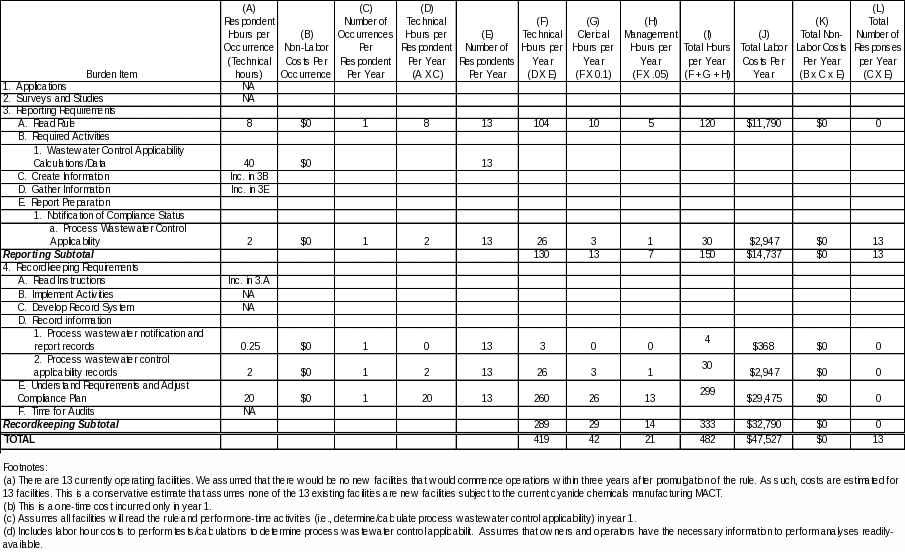
Table 2 - Annual Respondent Burden and Cost of Recordkeeping and Reporting Requirements for the Cyanide Chemicals Manufacturing RTR - Year 2
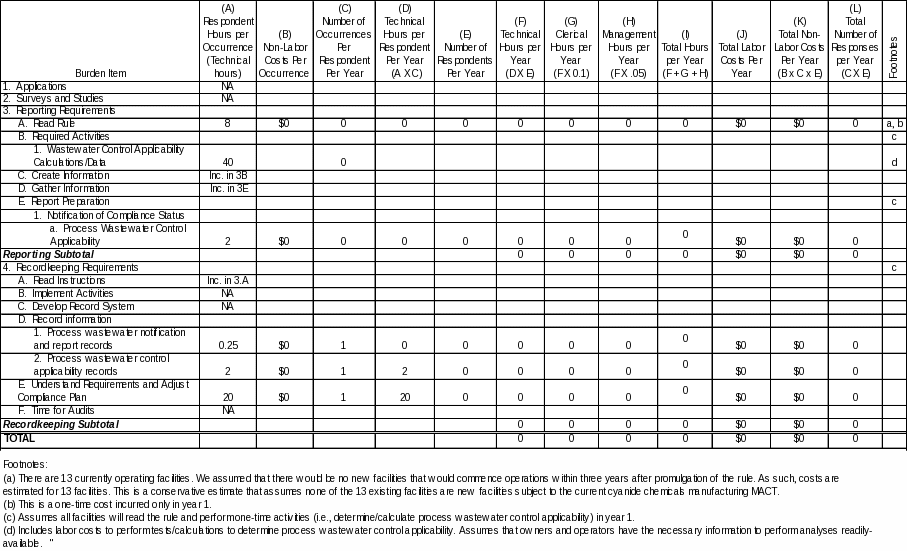
Table 3 - Annual Respondent Burden and Cost of Recordkeeping and Reporting Requirements for the Cyanide Chemicals Manufacturing RTR - Year 3
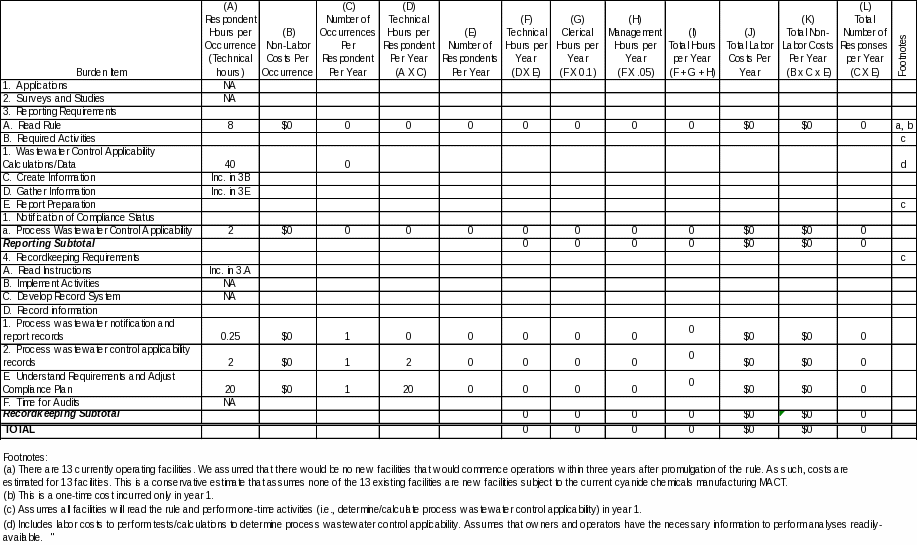
Table 4 - Summary of Annual Respondent Burden and Cost of Recordkeeping and Reporting Requirements for the Cyanide Chemicals Manufacturing RTR
Year |
Technical Hours |
Clerical Hours |
Management Hours |
Total Labor Hours |
Labor Costs |
Non-Labor (Annualized Capital/Startup and O&M) Costs |
Total Costs |
1 |
419 |
42 |
21 |
482 |
$47,527 |
$0 |
$47,527 |
2 |
0 |
0 |
0 |
0 |
$0 |
$0 |
$0 |
3 |
0 |
0 |
0 |
0 |
$0 |
$0 |
$0 |
Total |
419 |
42 |
21 |
482 |
$47,527 |
$0 |
$47,527 |
Average |
140 |
14 |
7 |
161 |
$15,842 |
$0 |
$15,842 |
|
|
|
|
|
|
|
|
Year |
Number of Respondents |
Number of Responses |
Reporting Hours |
Recordkeeping Hours |
Total Hours |
Hours per Response |
Hours Per Respondent |
1 |
13 |
13 |
150 |
333 |
482 |
37 |
37 |
2 |
0 |
0 |
0 |
0 |
0 |
0 |
0 |
3 |
0 |
0 |
0 |
0 |
0 |
0 |
0 |
Total |
13 |
13 |
150 |
333 |
482 |
37 |
37 |
Average |
4 |
4 |
50 |
111 |
161 |
12 |
12 |
ATTACHMENT 2
TABLES 5, 6, 7, and 8
Tables 5 - 7: Annual Agency Burden and Cost of Recordkeeping and Reporting Requirements for the Cyanide Chemicals Manufacturing RTR - Year 1-3
Table 8: Summary of Annual Agency Burden and Cost of Recordkeeping and Reporting Requirements for the Cyanide Chemicals Manufacturing RTR
Table 5 - Annual Agency Burden and Cost of Recordkeeping and Reporting Requirements for the Cyanide Chemicals Manufacturing RTR - Year 1
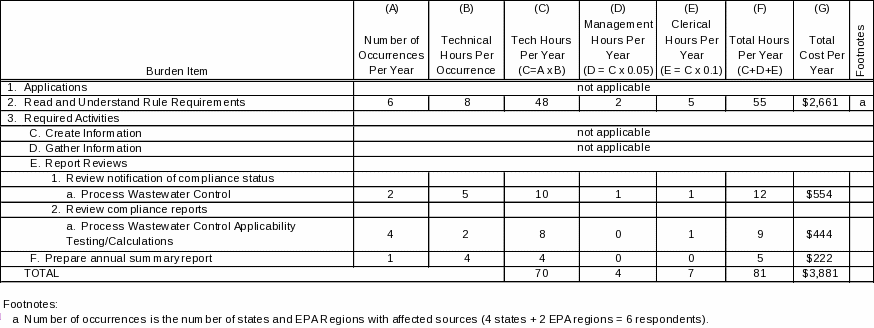
Table 6 - Annual Agency Burden and Cost of Recordkeeping and Reporting Requirements for the Cyanide Chemicals Manufacturing RTR - Year 2
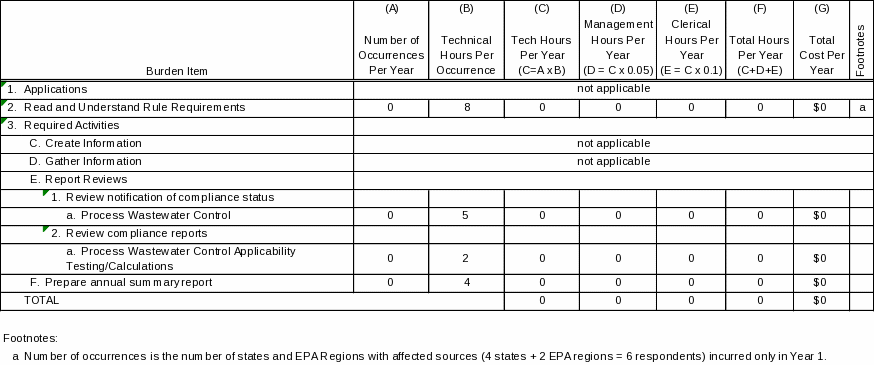
Table 7 - Annual Agency Burden and Cost of Recordkeeping and Reporting Requirements for the Cyanide Chemicals Manufacturing RTR - Year 3
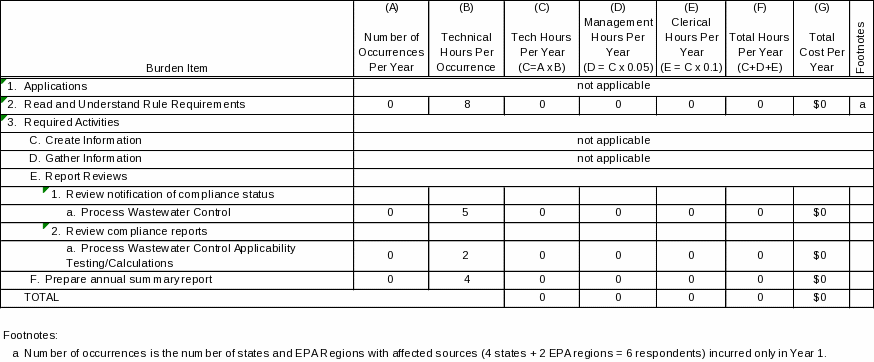
Table 8 - Summary of Annual Agency Burden and Cost of Recordkeeping and Reporting Requirements for the Cyanide Chemicals Manufacturing RTR
2 https://www.opm.gov/policy-data-oversight/pay-leave/salaries-wages/salary-tables/pdf/2019/GS_h.pdf
| File Type | application/vnd.openxmlformats-officedocument.wordprocessingml.document |
| File Title | Cyanide SUPPORTING STATEMENT |
| Author | ERG_BML |
| File Modified | 0000-00-00 |
| File Created | 2021-01-19 |
© 2025 OMB.report | Privacy Policy
